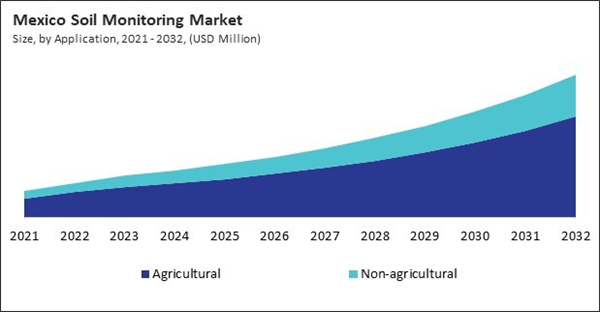The North America Soil Monitoring Market is expected to witness market growth of 13.9% CAGR during the forecast period (2025-2032).
The US market dominated the North America Soil Monitoring Market by country in 2024, and is expected to continue to be a dominant market till 2032; thereby, achieving a market value of $472.4 million by 2032. The Canada market is experiencing a CAGR of 15.7% during 2025-2032. Additionally, the Mexico market is expected to exhibit a CAGR of 15% during 2025-2032.
This market has evolved significantly over the past century, transitioning from manual assessments to sophisticated, technology-driven systems. In the early 20th century, soil evaluation primarily involved physical surveys and laboratory analyses, as exemplified by the USDA's soil survey initiatives, which laid the groundwork for understanding soil properties across the United States. These traditional methods, while foundational, were labor-intensive and time-consuming.
The latter half of the 20th century witnessed the integration of electronic sensors and data loggers, enabling more precise and continuous monitoring of soil parameters such as moisture, temperature, and nutrient levels. This period marked the beginning of a shift towards real-time data collection, facilitating more informed decision-making in agriculture and land management. In recent decades, advancements in information technology and the advent of the Internet of Things (IoT) have revolutionized soil monitoring practices.
This Market in North America has evolved significantly over the past several decades, transitioning from traditional soil assessment methods to sophisticated digital and sensor-based technologies. In recent years, the market has seen a major shift with the integration of precision agriculture tools such as GPS-enabled machinery, Internet of Things (IoT) devices, and satellite imagery. The evolution has also been supported by initiatives such as Canada’s National Land and Water Information Service and the USDA’s Climate Hubs, which provide farmers with region-specific soil and climate insights. The first trend is the increasing use of smart, IoT-enabled soil sensors across large-scale and smallholder farms alike. One of the foremost strategies is the integration of soil monitoring technologies with broader precision agriculture platforms. Hence, North America market is rapidly advancing through smart technologies and integrated platforms, driving a more data-driven and sustainable agricultural future.
The US market dominated the North America Soil Monitoring Market by country in 2024, and is expected to continue to be a dominant market till 2032; thereby, achieving a market value of $472.4 million by 2032. The Canada market is experiencing a CAGR of 15.7% during 2025-2032. Additionally, the Mexico market is expected to exhibit a CAGR of 15% during 2025-2032.
This market has evolved significantly over the past century, transitioning from manual assessments to sophisticated, technology-driven systems. In the early 20th century, soil evaluation primarily involved physical surveys and laboratory analyses, as exemplified by the USDA's soil survey initiatives, which laid the groundwork for understanding soil properties across the United States. These traditional methods, while foundational, were labor-intensive and time-consuming.
The latter half of the 20th century witnessed the integration of electronic sensors and data loggers, enabling more precise and continuous monitoring of soil parameters such as moisture, temperature, and nutrient levels. This period marked the beginning of a shift towards real-time data collection, facilitating more informed decision-making in agriculture and land management. In recent decades, advancements in information technology and the advent of the Internet of Things (IoT) have revolutionized soil monitoring practices.
This Market in North America has evolved significantly over the past several decades, transitioning from traditional soil assessment methods to sophisticated digital and sensor-based technologies. In recent years, the market has seen a major shift with the integration of precision agriculture tools such as GPS-enabled machinery, Internet of Things (IoT) devices, and satellite imagery. The evolution has also been supported by initiatives such as Canada’s National Land and Water Information Service and the USDA’s Climate Hubs, which provide farmers with region-specific soil and climate insights. The first trend is the increasing use of smart, IoT-enabled soil sensors across large-scale and smallholder farms alike. One of the foremost strategies is the integration of soil monitoring technologies with broader precision agriculture platforms. Hence, North America market is rapidly advancing through smart technologies and integrated platforms, driving a more data-driven and sustainable agricultural future.
List of Key Companies Profiled
- Campbell Scientific, Inc.
- CropX, Inc.
- Element Materials Technology (Temasek Holdings)
- Irrometer Company, Inc.
- METER Group, Inc.
- Spectrum Technologies, Inc. (BAE Systems PLC)
- Acclima, Inc.
- SGS S.A.
- The Toro Company
- Stevens Water Monitoring Systems, Inc.
Market Report Segmentation
By Application
- Agricultural
- Non-agricultural
By Offering
- Hardware
- Software
- Services
By Type
- Ground-based Sensing
- Sensing & Imagery
- Robotic & Telematics
By Country
- US
- Canada
- Mexico
- Rest of North America
Table of Contents
Chapter 1. Market Scope & Methodology
Chapter 2. Market at a Glance
Chapter 3. Market Overview
Chapter 4. Competition Analysis - Global
Chapter 5. Value Chain Analysis of Soil Monitoring Market
Chapter 6. North America Soil Monitoring Market by Application
Chapter 7. North America Soil Monitoring Market by Offering
Chapter 8. North America Soil Monitoring Market by Type
Chapter 9. North America Soil Monitoring Market by Country
Chapter 10. Company Profiles
Companies Mentioned
- Campbell Scientific, Inc.
- CropX, Inc.
- Element Materials Technology (Temasek Holdings)
- Irrometer Company, Inc.
- Irrometer Company, Inc.
- Spectrum Technologies, Inc. (BAE Systems PLC)
- Acclima, Inc.
- SGS S.A.
- The Toro Company








